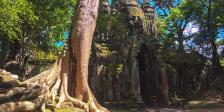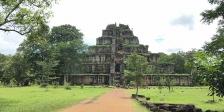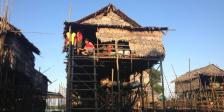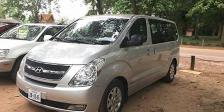Beng Mealea or Bung Mealea: its name means "lotus pond"[1]) is a temple in the Angkor Wat style located 40 km east of the main group of temples at Angkor, Cambodia, on the ancient royal highway to Preah Khan Kompong Svay.
It was built as a Hindu temple, but there are some carvings depicting buddhist motifs. Its primary material is sandstone and it is largely unrestored, with trees and thick brush thriving amidst its towers and courtyards and many of its stones lying in great heaps. For years it was difficult to reach, but a road recently built to the temple complex of Koh Ker passes Beng Mealea and more visitors are coming to the site, as it is 77 km from Siem Reap by road.
The corridor in the temple.
Beng Mealea is oriented toward the east, but has entranceways from the other three cardinal directions. The basic layout is three enclosing galleries around a central sanctuary, collapsed at present. The enclosures are tied with "cruciform cloisters", like Angkor Wat. Structures known as libraries lie to the right and left of the avenue that leads in from the east. There is extensive carving of scenes from Hindu mythology, including the Churning of the Sea of Milk and Vishnu being borne by the bird god Garuda. Causeways have long balustrades formed by bodies of the seven-headed Naga serpent.
It was built mostly of sandstone: Beng Mealea is only 7 km far from the angkorian sandstone quarries of Phnom Kulen, as the crow flies. Presumably sandstone blocks used for Angkor were transported along artificial water canals and passed from here
Koh Ker Group Temples
Koh Ker is a remote archaeological site in northern Cambodia about 120 kilometres (75 mi) away from Siem Reap and the ancient site of Angkor. It is a very jungle filled region that is sparsely populated. More than 180 sanctuaries were found in a protected area of 81 square kilometres (31 sq mi). Only about two dozen monuments can be visited by tourists because most of the sanctuaries are hidden in the forest and the whole area is not fully demined.
Koh Ker is the modern name for an important city of the Khmer empire. In inscriptions the town is mentioned as Lingapua (city of lingams) or Chok Gargyar (sometimes translated as city of glance, sometimes as iron tree forest)
Under the reign of the kings Jayavarman IV and Harshavarman II Koh Ker was briefly the capital of the whole empire (928–944 AD). Jayavarman IV forced an ambitious building program. An enormous water-tank and about forty temples were constructed under his rule. The most significant temple‑complex, a double sanctuary (Prasat Thom/Prang), follows a linear plan and not a concentric one like most of the temples of the Khmer kings. Unparalleled is the seven‑tiered and 36-metre (118 ft) high pyramid, which most probably served as state temple of Jayavarman IV. Really impressive too are the shrines with the two‑meter 6 ft 7 in high lingas.
Under Jayavarman IV the style of Koh Ker was developed and the art of sculpture reached a pinnacle. A great variety of wonderful statues were chiselled. Because of its remoteness the site of Koh Ker was plundered many times by looters. Sculptures of Koh Ker can be found not only in different museums but also in private collections. Masterpieces of Koh Ker are offered occasionally at auctions. These pieces in present times are considered stolen art.


 Hot Line: +855 88 7272 445
Hot Line: +855 88 7272 445










.jpg)

